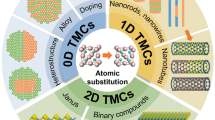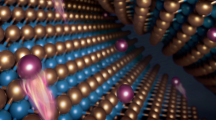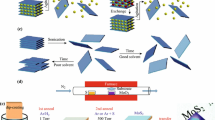Abstract
A new electrical conductive crystal PyEt[Ni(dmit)2]2 (dmit = 4,5-dimercapto-1,3-dithiole-2-thione) has been synthesized and its X-ray structure has been determined to be in monoclinic system, C2/c space group. In PyEt[Ni(dmit)2]2 crystal, the conducting component [Ni(dmit)2]0.5- is face-to-face packed forming molecular column along the c-direction, and these molecular columns are then side-by-side extended along the a-direction forming a kind of two-dimensional conducting sheet on (010). The measured conductivity at room temperature along a certain direction on (010) plane is 10 S · cm-1. From 282 to 269 K, the crystal shows metallic behavior but changes to semiconductor below 269 K. Based on the measured crystal structure and calculated band structure, this conductor-semiconductor phase transformation can be primarily interpreted: The metallic conductivity is corresponding to the uniform molecular column and the atomic-lattice-chain structure of Ni chain, while the semi-conductive behavior to staggered molecular column and the atomic-zigzag-chain structure of Ni chain.
Similar content being viewed by others
References
Fang Qi, Thomas, C. W. M., Zhou Zhongyuan et al., Syntheses and crystal structures of the molecular conductors Z[Pd(dmit)2]2 = (Me3NEt)+, (MeNEt3)+, NEt4+ and their precursors Z2[Pd(dmit)2], J. Chem. Soc., Dalton Trans., 2002: 1377–1385.
Fang Qi, Han Shiying, Lei Hong et al., ESR investigation of single crystal (Bu4N)2[Cu/Pd(dmit)2], Science in China, Series B, 1994, 37(6): 653–659.
Cassoux, P., Molecular (super)conductors derived from bis-dithiolate metal complexes, Coord. Chem. Rev., 1999, 185–186: 213–232.
Schlueter, J. A., Geise, R. U., Kini, A. M. et al., Trifluoromethylmetallate anions as components of molecular charge transfer salts and superconductors, Coord. Chem. Rev., 1999, 190–192: 781–810.
Kobayashi, A., Kim, H., Sasaki, Y. et al., The first molecular superconductor based on π-acceptor molecules and closed-shell cations, [(CH3)4N][Ni(dmit)2]2, low-temperature X-ray studies and superconducting transition, Chem. Lett., 1987: 1819–1822.
Bousseau, M., Valade, L., Legros, J. P. et al., Highly conducting charge-transfer compounds of tetrathiafulvalene and transition metal-“dmit” complex, J. Am. Chem. Soc., 1986, 108: 1908–1916.
Tajima, H., Inokuchi, M., Kobayashi, A. et al., First ambient-pressure superconductor based on Ni(dmit)2, α-EDT-TTF [Ni(dmit)2], Chem. Lett., 1993: 1235–1238.
Xu Wei, Zhang Deqing, Yang Chun et al., Synthesis, crystal structure and electrical conductivity of [bmim][Ni(dmit)2]3 (bmim = 1-butyl-3-methylimidazolium, dmit = 1,3-dithiol-2-thione-4,5-dithiolate), Synth. Met., 2001, 122: 409–412.
Veldhuizen, Y. S. J., Smeets, W. J. J., Veldman, N. et al., Synthesis and characterization of [acridinium][Ni(dmit)2]3 and [phenazinium][Ni(dmit)2]3(dmit = 2-thioxo-1,3-dithiole-4,5-dithiolate),Inorg. Chem., 1997, 36: 4930–4937.
Miyazaki, A., Izuoka, A., Sugawara, T. et al., Crystal structure of (ImH)[Ni(dmit)2]2 with intercolumnar interaction through an imidazolium counter ion, Bull. Chem. Soc. Jpn., 1992, 65: 2528–2530.
Xu Wen, Fang Qi, Xue Gang et al., Synthesis, structure and conductivity of molecular conductor (PyH)[Ni(dmit)2]2, Acta Chimica Sinica (in Chinese), 2002, 60: 2153–2158.
Xue Gang, Xu Wen, Yu Wentao et al., N-ethylpyridinium bis(2-thioxo-1,3-dithiole-4,5-dithiolato)nickelate, Acta Cryst., 2003, C59: m27-m29.
Fang Qi, Lei Hong, Xu Wen, Towards single-component molecular conductor [Ni(dmit)2] by charge disproportionation: 2[Ni(dmit)2]-0.5→ [Ni(dmit)2] + [Ni(dmit)2]-, Chinese Chem. Lett., 2003, 14: 1109–1112.
Alvarez, S., Vicente, R., Hoffmann R., Dimerization and stacking in transition-metal bisdithiolenes and tetrathiolates, J. Am. Chem. Soc., 1985, 107: 6253–6277.
Kobayashi, A., Sato, A., Kawano, K. et al., Origin of the resistivity anomalies of (EDT-TTF)[M(dmit)2](M = Ni, Pd), J. Mater. Chem., 1995, 5: 1671–1679.
Author information
Authors and Affiliations
Corresponding author
Rights and permissions
About this article
Cite this article
Fang, Q., Xu, W., Lei, H. et al. Synthesis, structure, and conductivity of molecular conductor (PyEt)[Ni(dmit)2]2 . Sc. China Ser. B-Chem. 46, 595–604 (2003). https://doi.org/10.1360/03yb0079
Received:
Issue Date:
DOI: https://doi.org/10.1360/03yb0079




